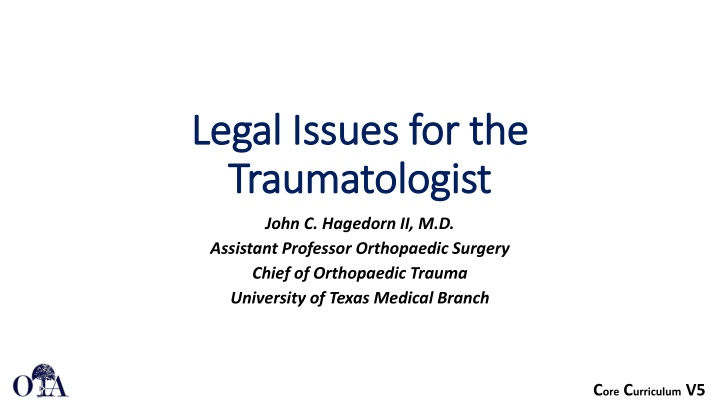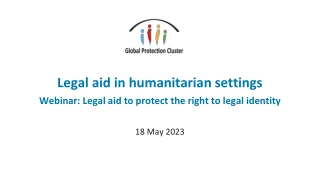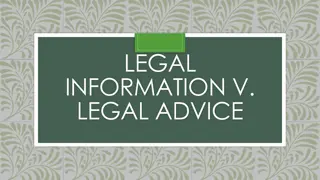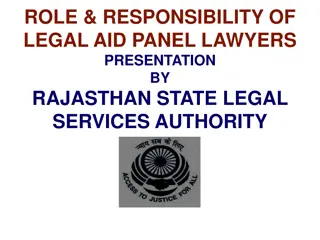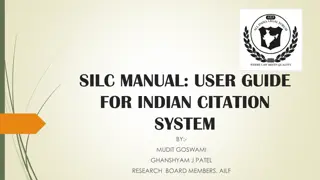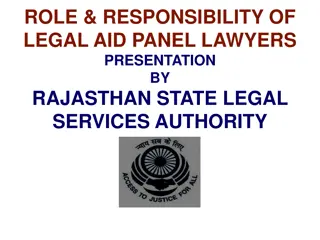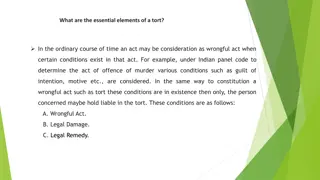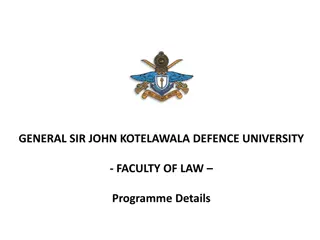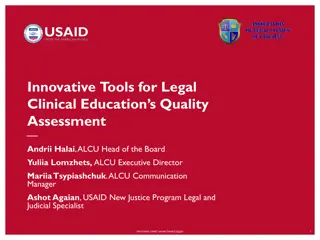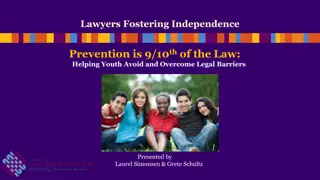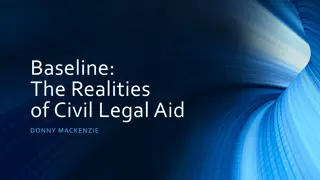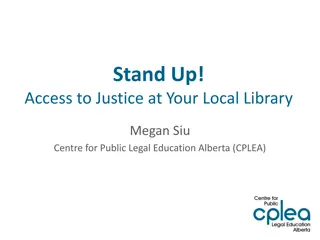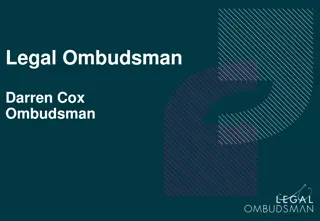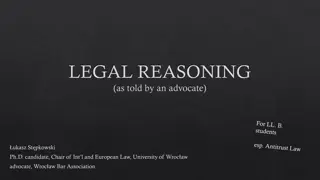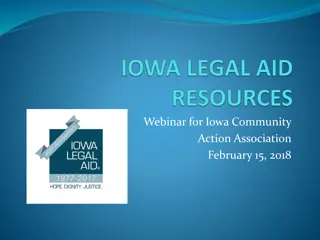Legal Issues Impacting Traumatologists
This presentation by Dr. John C. Hagedorn II, M.D., delves into the legal considerations relevant to traumatologists, covering laws like EMTALA and HIPAA, and discussing issues in patient treatment and practice management. Explore the established laws, transfer guidelines, and implications for trauma care providers.
Download Presentation

Please find below an Image/Link to download the presentation.
The content on the website is provided AS IS for your information and personal use only. It may not be sold, licensed, or shared on other websites without obtaining consent from the author.If you encounter any issues during the download, it is possible that the publisher has removed the file from their server.
You are allowed to download the files provided on this website for personal or commercial use, subject to the condition that they are used lawfully. All files are the property of their respective owners.
The content on the website is provided AS IS for your information and personal use only. It may not be sold, licensed, or shared on other websites without obtaining consent from the author.
E N D
Presentation Transcript
Legal Issues for the Legal Issues for the Traumatologist Traumatologist John C. Hagedorn II, M.D. Assistant Professor Orthopaedic Surgery Chief of Orthopaedic Trauma University of Texas Medical Branch Core Curriculum V5
Goal Goal At the conclusion of the presentation, the audience should be able to discuss and identify legal issues affecting the traumatologist Core Curriculum V5
Objectives Objectives 1. Name and describe established laws 2. Identify legal issues in the treatment of trauma patients 3. Identify legal issues in practice management Core Curriculum V5
Established Laws Established Laws 1. The Emergency Medical Treatment and Labor Act (EMTALA) 2. Health Insurance Portability and Accountability Act (HIPAA) 3. The Abused Patient Core Curriculum V5
Established Laws Established Laws The Emergency Medical Treatment and Labor Act (EMTALA) 1986 Requires Emergency Departments (ED) to: Screen patients for emergent conditions and stabilize these conditions Cannot discriminate on demographics or ability to pay Patient must be treated till stabilized or emergent condition resolved Also know as anti-dumping law Cannot prematurely transfer un- or underinsured patients Strict Transfer guidelines Core Curriculum V5
Established Laws Established Laws The Emergency Medical Treatment and Labor Act (EMTALA) 1986 EMTALA does not apply to stable patients An unstable patient may be transferred if: Benefits of transfer outweigh the risks as certified by a physician Written transfer request is made by patient after the risk-benefit of the transfer is discussed AND the patient knows the hospitals requirements under EMTALA Transfer guidelines Transfers must be appropriate as defined by the law: Transferring hospital must continue care within capabilities until transfer Supply copies of medical records Receiving hospital has agreed to the transfer and has qualified personnel and space Qualified personnel and medical equipment required for transfer Hospitals cannot transfer to a lower level of care Core Curriculum V5
Established Laws Established Laws The Emergency Medical Treatment and Labor Act (EMTALA) 1986 Penalties for violation Loss of hospital and/or physician s ability to see Medicare patients Hospital fines Physician fines Receiving hospitals can sue for damages from another hospitals EMTALA violation Core Curriculum V5
Established Laws Established Laws Health Insurance Portability and Accountability Act (HIPAA) 1996 Designed to protect sensitive patient health information from being shared without patient consent or knowledge HIPAA is enforced using two rules HIPAA Privacy Rule HIPAA Security Rule Core Curriculum V5
Established Laws Established Laws Health Insurance Portability and Accountability Act (HIPAA) 1996 HIPAA Privacy Rule Addresses the use and disclosure of protected health information by covered entities Allows patients to control how health information is used Goal is to allow patient information to be shared to provide high quality patient care, but to do it in a protected manner Examples of Covered entities: Insurance companies Healthcare providers Business entities (i.e. hospitals) Core Curriculum V5
Established Laws Established Laws Health Insurance Portability and Accountability Act (HIPAA) 1996 HIPAA Privacy Rule Covered entities can disclose information to: The patient Individuals or groups involved in treatment, payment and healthcare operations Research, public health, other approved datasets (if redacted) Persons/entities requested by the patient Situations of public interest/benefit such as but not limited to: Abuse Victims Law enforcement Identification of deceased person Health Oversight When required by law Core Curriculum V5
Established Laws Established Laws Health Insurance Portability and Accountability Act (HIPAA) 1996 HIPAA Security Rule Applies to any electronic protected health information (e-PHI) Does not apply to PHI communicated in writing or orally To be compliant a covered entity must: Ensure confidentiality, integrity, and availability of all e-PHI Identify and protect information from security threats Protect information from potential improper uses or disclosures Ensure that workforce is compliant Core Curriculum V5
Established Laws Established Laws Health Insurance Portability and Accountability Act (HIPAA) 1996 Penalties for violations All complaints reported to HHS Office for Civil Rights Monetary penalties Can carry criminal penalties Severity of penalty is related to the level of negligence Core Curriculum V5
Established Laws Established Laws The Abused Patient Children, adults and elders are all at risk for abuse As a physician it is your responsibility to identify abuse As a physician you need to report abuse according to governing rules and laws Abuse can be the reason for presenting with a medical complaint Core Curriculum V5
Established Laws Established Laws The Abused Patient Child abuse Definition: Any recent act or failure to act on the part of a parent or caretaker, which results in death, serious physical or emotional harm, sexual abuse or exploitation. Occurs in over 1 million children per year in the United States Presentation/Suspected Abuse: Inconsistent story from caregiver Femur fracture in non-ambulatory child Multiple bruises in multiple stages of healing Delayed presentation for care Corner fractures on x-ray Skin changes most common Core Curriculum V5
Established Laws Established Laws The Abused Patient Child abuse Child Abuse Prevention and Treatment Act (CAPTA) is a federal law that sets: Minimal standards for reporting Mandates states have mechanism to report In the all US States child abuse is required to be reported to child protective services (CPS) if suspect by a healthcare provider Reporters only need to report the facts and do not bear the burden of proof. Importance of reporting Child abuse is the second most common cause of death Up to 50% chance of repeat abuse and up to 10% chance of death Core Curriculum V5
Established Laws Established Laws The Abused Patient Adult/Domestic Abuse Definition: Pattern of behaviors used by one partner to maintain power and control over another partner in an intimate relationship. Also known as: intimate partner violence, relationship abuse Affects women more than men Around 1/3 of women presenting to ED with injuries are due to domestic violence Child abuse can be as high as 50% in homes with domestic abuse Core Curriculum V5
Established Laws Established Laws The Abused Patient Adult/Domestic Abuse Risk Factors: Female Pregnant Short relationship Low-Socioeconomic status Presentation/Suspected Abuse: Flat Affect Repeat ED visits Refusal or excuses to delay discharge home Delay between injury and seeking treatment Core Curriculum V5
Established Laws Established Laws The Abused Patient Adult/Domestic Abuse Reporting Unlike child abuse most states physicians do not have the authority to report suspect abuse If abuse suspected Be familiar with state law requirements Enquire if patient is safe at home Provide resources Encourage patient to report incidents to law enforcement Document encounter and interventions carefully Core Curriculum V5
Established Laws Established Laws The Abused Patient Elder Abuse Definition: Is the exploitation, abuse or neglected of an adult over 65 years old. Exploitation is often monetary in nature Male and Female Genders affected equally Around 2 million elders in American affected a year Core Curriculum V5
Established Laws Established Laws The Abused Patient Elder Abuse Risk Factors: Functional or cognitive impairment Increasing age Caretake is dependent on the elder person (i.e. financially) Presentation/suspected abuse: Burns/bruising Sudden changes to daily activities or cognition. Drastic changes to financial situation/status Tense relationships or reoccurring arguments between elder and caregiver. Core Curriculum V5
Established Laws Established Laws The Abused Patient Elder Abuse Reporting All states have a mechanism to report elder abuse and physicians are mandated to report Concerns are reported to Adult Protective Services (APS) If elder is in immediate danger you can: Call law enforcement Admit to hospital Core Curriculum V5
Legal Issues In The Treatment of Trauma Patients Legal Issues In The Treatment of Trauma Patients 1. Informed Consent 2. Medical Power of Attorney (MPOA) and Living Will 3. Do not resuscitate/Do not intubate (DNR/DNI) Core Curriculum V5
Legal Issues In The Treatment of Trauma Patients Legal Issues In The Treatment of Trauma Patients Informed Consent Definition: The process of telling a patient their diagnosis, the recommended treatment, and the risks and benefits of pursuing or not pursuing the recommended treatment. All patient should have the opportunity to ask questions in the informed consent process to understand their condition and procedure. A consent form should be signed establishing agreement between the surgeon and patient. If informed consent is not obtained it can be considered assault/battery if procedures are performed. Core Curriculum V5
Legal Issues In The Treatment of Trauma Patients Legal Issues In The Treatment of Trauma Patients Informed Consent Some patients cannot give informed consent due to: Age Under 18 (minors) Parents or guardian can give informed consent Certain states have exceptions for minors to give informed consent (i.e. pregnant minors, emancipated minors, minor seeking treatment for drug dependence). Cognitive disability Appointed guardian (parents, family, state official) can give informed consent Core Curriculum V5
Legal Issues In The Treatment of Trauma Legal Issues In The Treatment of Trauma Patients Patients Informed Consent Some patients cannot give informed consent due to: Emergent situations Every attempt should be made to obtain informed consent per state and hospital policy especially before surgical procedures. If informed consent cannot be obtained and emergent procedure and treatment is needed then implied consent should be utilized Implied consent assumes that if the patient was aware of their emergent situation, they would want their emergent conditions treated under the reasonable man standard to save their life/limb. If implied consent is used patient, family or guardian should be informed as soon as possible about the applied intervention during the emergent situation Core Curriculum V5
Legal Issues In The Treatment of Trauma Patients Legal Issues In The Treatment of Trauma Patients Medical power of attorney (MPOA) and Living Will In situations where a patient cannot make decisions two pathways exist for decisions to be made on the patient's behalf according to their wishes Medical Power of attorney (MPOA) is a person appointed by the patient to make medical decisions on their behalf if they cannot A Living Will is a document that the patient expresses treatment wishes in to help guide treatment if they cannot make their own decisions MPOA and a living will are not mutually exclusive and if both exist the directives in a living will take precedent over the MPOA. Core Curriculum V5
Comparison of MPOA and Living Will Comparison of MPOA and Living Will MPOA Person appointed to make decisions Living Will Patients own wishes written out Usually refers to specific situations and action to take MPOA and patient discuss wishes MPOA is expected to make the best decision with patient wishes in mind If living will take precedent over MPOA if the will addresses the situation Core Curriculum V5
Legal Issues In The Treatment of Trauma Patients Legal Issues In The Treatment of Trauma Patients Do not resuscitate/Do not intubate (DNR/DNI) Patients can have very specific wishes regarding life saving measures. A Do Not Resuscitate order (DNR) states that no life saving measures (i.e. hemodynamic support with medication) should be taken to keep them alive A Do Not Intubate order (DNI) means the patient does not want intubation to keep them alive but does not in itself exclude measures or resuscitation. Like a living will DNR/DNI orders override MPOA orders, but an MPOA can decide to make a patient DNR/DNI if that patient has stated so Core Curriculum V5
Comparison of DNR and DNI Comparison of DNR and DNI DNR DNI No resuscitative measures used to keep alive No vasopressors for hypotension No intubation can be used to keep patient alive BUT . No ventilation for respiratory failure Patient can be given resuscitative measures to keep alive Vasopressor to treat hypotension No antibiotics to treat infection No Cardiopulmonary Resuscitation (CPR) Antibiotics to treat infection Can perform CPR Core Curriculum V5
Legal Issues In The Treatment of Trauma Patients Legal Issues In The Treatment of Trauma Patients Do not resuscitate/Do not intubate (DNR/DNI) Some procedures are considered palliative in nature such as: Cephalomedullary nail for hip fracture in an elderly patient to control pain Treatment of long bone metastatic disease to prevent fracture In these situations a patient may have a DNR/DNI in place and discussion should be pursued about suspending these for the duration of the palliative procedure Not all states/hospitals require DNR/DNI to be suspended during palliative procedures Suspension allows the treatment team to correct life-threatening conditions during and around the procedure to allow the patient to live to benefit from the intervention Core Curriculum V5
Legal Issues In Practice Management Legal Issues In Practice Management 1. Conflict of Interest (COI) 2. Second Opinion Doctors 3. Advertising Core Curriculum V5
Legal Issues In Practice Management Legal Issues In Practice Management Conflict of Interest (COI) Definition: A situation in which a person has a private or personal interest sufficient to appear to influence the objective exercise of his or her official duties as, say, a public official, an employee, or a professional. Patients should be informed of potential COIs when appropriate to completely disclose and inform them of the treatment plan In Orthopaedics COIs can occur through a few different mechanisms. Therefore it is important to recognize and disclose all possible COIs Core Curriculum V5
Legal Issues In Practice Management Legal Issues In Practice Management Conflict of Interest (COI) Royalties Payments made from a company to physician. Payments can occur for: Speaking for the company Designing implants Global implant utilization Conducting research/trails If utilizing an implant on a patient, you should disclose any royalties or conflicts related to using that implant to the patient Core Curriculum V5
Legal Issues In Practice Management Legal Issues In Practice Management Conflict of Interest (COI)-Mitigation The Physician Payments Sunshine Act (PPSA) 2010 Part of the Affordable Care Act Requires medical product manufactures to report all and any payments made to physicians Goal was to increase transparency of the relationship between the physician and the medical industry pharma and implants Database available on the internet for public to access https://openpaymentsdata.cms.gov/ Core Curriculum V5
Legal Issues In Practice Management Legal Issues In Practice Management Conflict of Interest (COI) Physicians can also own interest in surgery centers, medical equipment such as MRIs, and therapy centers which can create a conflict of interest. Physicians can be conflicted to self-refer patients for health services to entities they own which potentially could carry civil law consequences These conflict have been managed and addressed by Anti- kickback Statute and Physician Self-Referral Laws (Stark Laws) Core Curriculum V5
Legal Issues In Practice Management Legal Issues In Practice Management Conflict of Interest (COI)-Mitigation Anti-kickback Statute Criminal statute Prohibits the exchange of anything of value, in an effort to induce the referral of business reimbursable by federal health care programs. Prohibited activities include: Financial incentives for referrals Waving co-payments either as practice or selectively Kickbacks have led to increasing healthcare costs Violators can face fines, jail time and risk being excluded from seeing Medicare/Medicaid patients Core Curriculum V5
Legal Issues In Practice Management Legal Issues In Practice Management Conflict of Interest (COI)-Mitigation The Physician self-referral laws (Stark Laws) Civil Law Stark I: prohibited physicians from referring Medicare patients to a clinical laboratory that the physician or their family had a financial interest in. Stark II: expanded Stark I to included Medicaid patients. Stark II also prevent physicians from referring patients to Designated Health Services (DHS) that a physician had financial interest in. DHS included but are not limited to: Durable medical equipment/prosthetics Home health services Outpatient pharmacy services Core Curriculum V5
Legal Issues In Practice Management Legal Issues In Practice Management Conflict of Interest (COI)-Mitigation The Physician self-referral laws (Stark Laws) Exceptions to Stark Laws include but are not limited to: Referral to a doctor who is a member of the same group practice Services are done in the same location as the treating doctor Intra-family rural referrals Penalties for Stark Law violations Carries no jail time Can have significantly higher financial penalties compared to Anti- kick back laws Core Curriculum V5
Legal Issues In Practice Management Legal Issues In Practice Management Second opinion doctor Occasionally patients or doctors will seek a second opinion to help care for the patient The second opinion doctor has an ethical, but no legal obligation to discuss previous care that deviated from the standard of care. If your patient seeks a second opinion you: Should supply medical records with their consent Cannot terminate the physician patient relationship The second opinion doctor does not have to assume the patient s care Core Curriculum V5
Legal Issues In Practice Management Legal Issues In Practice Management Advertising Physician advertising is governed by the Federal Trade Commission Act Advertising is allowed as long as advertising is not false, deceptive or misleading Examples of misleading advertising Bloodless surgery Painless surgery Offering a cure for a disease which no cure exists Core Curriculum V5
Summary Summary Multiple laws ensure that the care of trauma patients is consistent, and penalties exist for those surgeons and entities that do not comply While child and elder abuse is reportable, reporting domestic violence between adults varies by state and local laws. Multiple situations exist where patient may not be able to give informed consent and mechanisms to ensure patients are cared for by their wishes even when they cannot give consent Conflicts of interest can arise from royalties, physician payments and referrals. Knowledge of the laws and disclosure of these conflicts are important in provide transparent patient care. Advertising by physicians is not illegal; but advertisements cannot be deceptive in nature. Core Curriculum V5
References References 1. American College of Emergency Physicians. EMTALA Fact Sheet. American College of Emergency Physicians. Accessed: September 3, 2020. https://www.acep.org/life-as-a-physician/ethics--legal/emtala/emtala-fact- sheet/#:~:text=The%20Emergency%20Medical%20Treatment%20and,has%20remained%20an%20unfunded%20mandate. 2. Public Health Professionals Gateway. Health Insurance Portability and Accountability Act of 1996 (HIPAA). Centers for Disease Control and Prevention. Updated: September 14, 2018. Accessed: September 3, 2020. https://www.cdc.gov/phlp/publications/topic/hipaa.html 3. Child Welfare Information Gateway. Mandatory Reporters or Child Abuse and Neglect. Child Welfare Information Gateway. Updated: April 2019. Accessed: September 4, 2020. https://www.childwelfare.gov/pubPDFs/manda.pdf 4. National Domestic Violence Hotline. Understand Relationship Abuse. National Domestic Violence Hotline. Accessed: September 3, 2020. https://www.thehotline.org/identify-abuse/understand-relationship-abuse/ 5. Administration for Community Living. What if I suspect Abuse, Neglect or Exploitation? U.S Department of health and Human Services. Accessed: September 4, 2020. https://acl.gov/programs/protection-and-advocacy-systems/what-if-i-suspect-abuse-neglect-or-exploitation 6. American Cancer Society. What Is Informed Consent? American Cancer Society. Updated: May 13, 2019. Accessed: September 4, 2020. https://www.cancer.org/treatment/finding-and-paying-for-treatment/understanding-financial-and-legal-matters/informed-consent/what-is-informed- consent.html 7. Katz, P. Separating DNI from DNR discussions. Today sHospitalist. Published: October 2014. Accessed: September 4, 2020. https://www.todayshospitalist.com/separating-dni-from-dnr-discussions/ 8. Roberts, C., Battista, C. Conflict of Interest vs competition of interest in orthopaedic surgery. Injury. 2011, July 01; 42(7), 615-616. 9. Sullivan, T. Physician Payment Sunshine Act Final Rule: Definitions. Policy & Medicine. Updated: May 6, 2018. Accessed: September 11, 2020. 10. Health Care Fraud Prevention and Enforcement Team. Comparison of the Anti-Kickback Statute and Stark Law. Office of Inspector General. Accessed: September 4, 2020. https://oig.hhs.gov/compliance/provider-compliance-training/files/starkandakscharthandout508.pdf 11. Pandya, S. Taking a Second Look. Indian Journal of Medical Ethics. Volume 6(1). 12. Federal Trade Commission. Federal Trade Commission Act. Federal Trade Commission. Updated: 2006. Accessed: September 21, 2020. Core Curriculum V5
